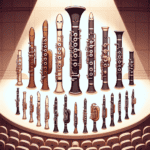As you start your journey as a clarinet player, knowing how to put together a clarinet correctly is key. Whether you're new to the instrument or have years of experience, the right assembly technique can significantly affect the sound and performance of your clarinet. Let's go through the steps of assembling a clarinet, along with some useful tips.
Getting to Know Your Clarinet Parts
Before we begin assembling, let's familiarize ourselves with the main components of the clarinet:
- Mouthpiece: The part you blow into, which holds the reed.
- Barrel: Connects the mouthpiece to the upper joint.
- Upper Joint: Contains the key mechanism and important areas for finger placement.
- Lower Joint: Connects to the bell and has additional keys and tone holes.
- Bell: The final section of the clarinet that helps project the sound.
| Part | Function |
|---|---|
| Mouthpiece | Holds the reed and creates initial sound |
| Barrel | Connects mouthpiece to upper joint |
| Upper Joint | Houses main key mechanism |
| Lower Joint | Contains additional keys and tone holes |
| Bell | Projects the final sound |
The Assembly Process
Now that you're familiar with the parts, let's put the clarinet together step-by-step:
- Prepare Your Workspace: Choose a flat, clean surface to prevent damage to your clarinet. Place a soft cloth underneath to avoid scratches.
- Attach the Mouthpiece: Start with the barrel. Line up the mouthpiece with the barrel, then gently twist until it fits snugly. Don't use too much force, as this can damage the cork.
- Connect the Barrel to the Upper Joint: Line up the barrel with the upper joint, making sure to position the keys correctly. Push them together firmly until they lock into place.
- Connect the Upper Joint to the Lower Joint: Similar to the previous step, line up and press the upper joint into the lower joint. Make sure the bridge key aligns properly with the lower joint.
- Attach the Bell: Lastly, secure the bell onto the lower joint. Check that all parts are connected without forcing them together.
Preparing the Mouthpiece
After you've put the clarinet together, it's time to get the mouthpiece ready for playing:
- Moisten the Reed: Before putting the reed on the mouthpiece, moisten it to help it vibrate effectively. A quick dip in water or a few breaths will do the trick.
- Position the Reed: Put the reed on the mouthpiece, making sure it covers the tip completely and lines up with the mouthpiece's tip.
- Secure the Reed: Use your ligature to hold the reed in place. Tighten it gently, making sure it's not too tight, as that can stop the reed from working properly.
Final Checks Before You Play
After putting everything together and positioning the reed, do a quick check:
- Key Movement: Press each key by hand to make sure they move smoothly.
- Sound Quality: Blow into your instrument while covering the tone holes to check if any are blocked.
- Overall Feel: Make sure the clarinet feels balanced and comfortable when you hold it.
Troubleshooting Assembly Issues
Sometimes, things don't go as planned when putting your clarinet together. Here are some common problems and how to fix them:
- Key Misalignment: If the keys aren't lining up right, try twisting the sections you're connecting slightly to find a better fit.
- Sound Problems: If the sound is weak or uneven, check if the reed is too dry or not lined up properly.
- Tight Connections: If the joints feel too tight, put a little cork grease on the cork areas to make assembly easier.
Making Assembly a Routine
Put your clarinet together regularly to get used to the process. This will help you understand your instrument better and solve problems quickly. Good clarinet makers like Martin Freres stress how important it is to know your instrument well as part of becoming a better musician.
Whether you're getting ready for a concert or just practicing at home, a well-assembled clarinet makes your playing experience better and brings your music to life. Have fun on your musical journey, and enjoy playing!







